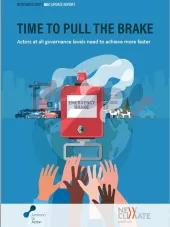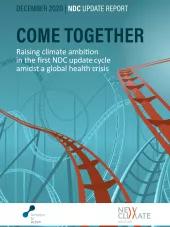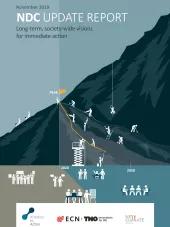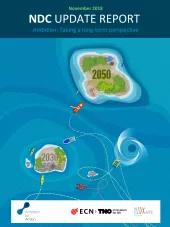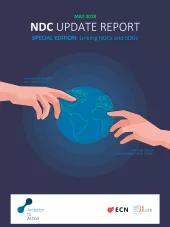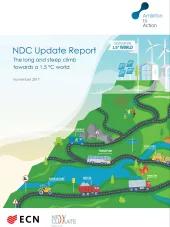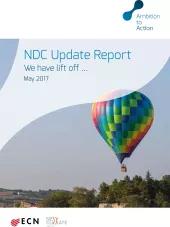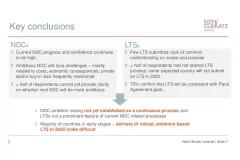To reach the long-term temperature goal of the Paris Agreement, most countries will need to reduce emissions to net-zero in 2050 or shortly thereafter. This report considers this challenge from a sector perspective, examining decarbonisation from several different angles. For the following five key sectors: power, industry, transport, buildings, and agriculture, forestry and other land-use, it highlights the leading mitigation options and their implications for longer-term planning. The report further describes how modelling and developing scenarios can support mitigation planning, and how political economy analysis can complement technology focused approaches to get a better understanding of the feasibility of sector transition pathways.
Key messages:
The IPCC special report on the impacts of global warming of 1.5 °C, published in October last year, provides clarity on what it might take to reach the long-term goal of the Paris Agreement to stay well below two degrees of warming: decarbonisation needs to happen not ‘sometime in the second half of the 21st century‘ as was the understanding until recently, but rather in 2050 or shortly thereafter. By 2030 sector transformations need to be well on their way. While all signatories to the Paris Agreement need to submit their new and updated Nationally Determined Contributions (NDCs) next year, it is widely acknowledged that at the moment we are not progressing fast enough collectively and countries are not ambitious enough to meet the Paris goal.
This mid-year edition of the NDC Update Report focuses on sector decarbonisation pathways. We discuss what it takes to think through the choices involved in shaping a Paris-compatible sector future from a number of different perspectives.
Chapter 2 presents the main decarbonisation options for five main sectors – power, industry, transport, buildings, and agriculture and land-use – and shows that in each sector there are choices and decisions to be made. These choices cannot be left until after 2030 and will need to feature in the next rounds of NDCs, ideally as a reflection of a well-informed long-term strategy. Key decarbonisation options have different requirements for the development of technology and associated infrastructure and if the right choices are not made in a timely manner, there is a risk of path-dependency, locking a country into sub-optimal sector pathways.
Time is an important consideration here: introducing alternatives at a later stage would likely be inefficient and costly and might not be achievable given the long lead times for planning and delivery of large infrastructure. Consumer campaigns will likely need to be put in place quite far in advance of the introduction of major policies and regulations, which means they may be necessary within pre- 2030 timescales. Moreover, interactions between sectors, for example related to the increase in power demand as a result of electrification across sectors or the multiple uses of biomass, call for deliberate economy-wide coordination.
Chapter 3 looks at how global scenarios and goals can be translated into feasible policies, plans, and strategies to enable sector decarbonisation. It presents different modelling approaches to translate science and global pathways to sector and subsector contexts. The power of scenario modelling lies in its ability to explore potential future developments under varying assumptions, and to provide an evidence base to better understand the implications of different pathways options. Bottom-up modelling approaches such as least-cost optimisation to determine cost effective mitigation pathways, can be complemented with equity approaches which use top-down methods to allocate the global mitigation burden fairly among countries or sectors based on specific criteria.
Because the choice of model and approach has a significant impact on the results, it is important to understand the options and potential of each one. Models can by no means capture the full breadth of dynamic complexities of entire sectors and economies given computational constraints. Hence for a nuanced perspective, a combination of different approaches may be needed. When developing Paris-compatible pathways, stakeholders may have different perspectives on assumptions, plausibility, and political feasibility. Transparency, dialogue, and communications are key in aligning stakeholders with potentially conflicting needs, perspectives, and expectations; transparent modelling exercises provide a solid basis to enable this and governments can play a key role as mediators in this process.
Chapter 4 looks at Political Economy Analysis (PEA) as an approach to understanding the politics of sector transitions. Sector transitions are not only technical or economic challenges, but also involve political processes regarding stakeholders who might gain or lose income and opportunities as a result of choices made. A better understanding of the political dynamics in the sector will allow for a more realistic assessment of which actions and pathways are feasible – important when shaping effective policies and programmes to drive Paris-compatible sector transitions. Since the late 1990s, development assistance agencies have been developing and using diagnostic tools to analyse why ‘lack of political will’ prevents technically feasible and properly funded projects from being effective. PEA is the diagnostic approach that has emerged, with the aim of finding out what is ‘really going on’ in a situation: who influences change and whether and where competing interests exist.
Most examples of PEA are conducted from an external perspective, for example by donors analysing the national and sectoral political dynamics in partner countries, and not by governments as part of their own stakeholder engagement thinking and processes. We are however optimistic that political economy analysis can also be used in support of sector planning (i.e. from inside the process) in one way or another: especially for ‘big decisions’ about technology pathways and for achieving the most difficult (and obviously last) 10-20% of emissions reduction, where political dynamics matter in identifying which actions are feasible and which are not.
The final chapter, Chapter 5, contains contributions from experts in the NDC Cluster working groups, looking at the medium-term challenges of sector decarbonisation and the short-term implications for policy makers and planners.
From a transparency perspective, clarity on sectoral pathways is needed to guide domestic implementation. Transparency can significantly strengthen the quality of the sectoral decarbonization strategy, as well as its legitimacy and durability. This includes considerations of transparency of inputs and methodology, transparency of the development process, and transparency of communication.
From a finance perspective, the challenge is to mobilise Paris-compatible investments at scale and avoid ‘carbon lock-in’ through sub-optimal technology pathways. This will require significant use of public resources and close collaboration with private sector actors (in particular the financial sector and institutional investors). Short-term interventions are needed to make green investments financially attractive and to provide access to affordable early stage financing.
From a governance perspective, the following short-term enablers need to be in place by 2025 in order to lay the foundations for a global net-zero emissions future in 2050: Developing a clear long term vision; upgrading governance capacities for a systemic, whole-of-society approach; integrating decarbonization strategies with sustainable development pathways; and developing clear implementation plans, including short and medium term goals that are clearly stated in revised NDCs and related plans.
Looking ahead at 2020, we see a risk that the new NDCs will focus on intermediate targets without a robust underlying long-term strategy towards 2050, and that pathways compatible with medium term targets in NDCs may not be ambitious or comprehensive enough to reach the long-term target of full decarbonisation across sectors. In order to avoid such incompatibility and prevent the need for potentially more costly corrective actions later, it is crucial that governments start to seriously and coherently develop long-term sector strategies towards 2050 as new NDCs are considered and updated.
For many countries, and developing countries in particular, answering questions related to which options to implement and when, and how and why to involve stakeholders and consumers may seem complex and daunting.
However, as this report shows, there are approaches that can help such as scenario modelling, analysis of the political dynamics, and forward-looking approaches relating to transparency, public and private finance, and governance.


